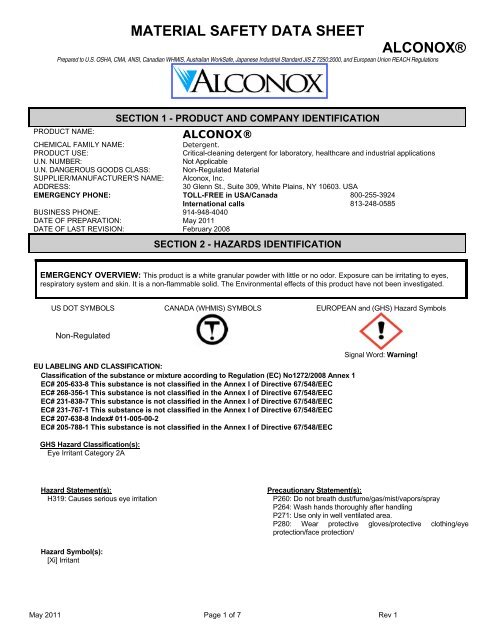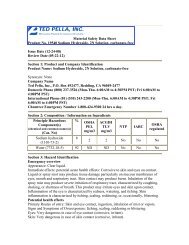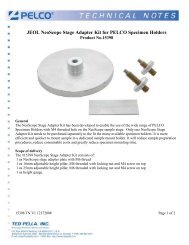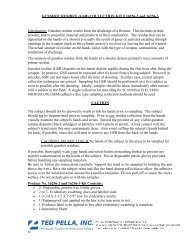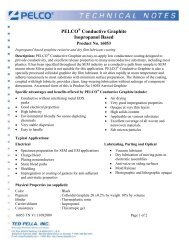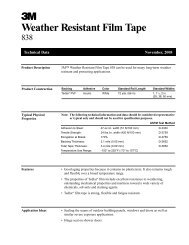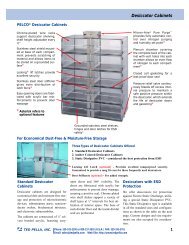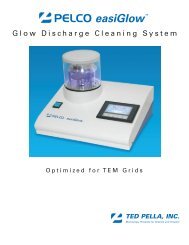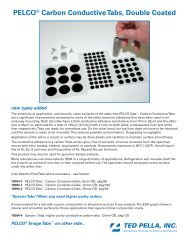Alconox MSDS.pdf - Ted Pella, Inc.
Alconox MSDS.pdf - Ted Pella, Inc.
Alconox MSDS.pdf - Ted Pella, Inc.
Create successful ePaper yourself
Turn your PDF publications into a flip-book with our unique Google optimized e-Paper software.
MATERIAL SAFETY DATA SHEETALCONOX®Prepared to U.S. OSHA, CMA, ANSI, Canadian WHMIS, Australian WorkSafe, Japanese Industrial Standard JIS Z 7250:2000, and European Union REACH RegulationsPRODUCT NAME:SECTION 1 - PRODUCT AND COMPANY IDENTIFICATIONALCONOX®CHEMICAL FAMILY NAME:Detergent.PRODUCT USE:Critical-cleaning detergent for laboratory, healthcare and industrial applicationsU.N. NUMBER:Not ApplicableU.N. DANGEROUS GOODS CLASS: Non-Regulated MaterialSUPPLIER/MANUFACTURER'S NAME: <strong>Alconox</strong>, <strong>Inc</strong>.ADDRESS:30 Glenn St., Suite 309, White Plains, NY 10603. USAEMERGENCY PHONE: TOLL-FREE in USA/Canada 800-255-3924International calls 813-248-0585BUSINESS PHONE: 914-948-4040DATE OF PREPARATION: May 2011DATE OF LAST REVISION: February 2008SECTION 2 - HAZARDS IDENTIFICATIONEMERGENCY OVERVIEW: This product is a white granular powder with little or no odor. Exposure can be irritating to eyes,respiratory system and skin. It is a non-flammable solid. The Environmental effects of this product have not been investigated.US DOT SYMBOLS CANADA (WHMIS) SYMBOLS EUROPEAN and (GHS) Hazard SymbolsNon-RegulatedSignal Word: Warning!EU LABELING AND CLASSIFICATION:Classification of the substance or mixture according to Regulation (EC) No1272/2008 Annex 1EC# 205-633-8 This substance is not classified in the Annex I of Directive 67/548/EECEC# 268-356-1 This substance is not classified in the Annex I of Directive 67/548/EECEC# 231-838-7 This substance is not classified in the Annex I of Directive 67/548/EECEC# 231-767-1 This substance is not classified in the Annex I of Directive 67/548/EECEC# 207-638-8 Index# 011-005-00-2EC# 205-788-1 This substance is not classified in the Annex I of Directive 67/548/EECGHS Hazard Classification(s):Eye Irritant Category 2AHazard Statement(s):Precautionary Statement(s):H319: Causes serious eye irritation P260: Do not breath dust/fume/gas/mist/vapors/sprayP264: Wash hands thoroughly after handlingP271: Use only in well ventilated area.P280: Wear protective gloves/protective clothing/eyeprotection/face protection/Hazard Symbol(s):[Xi] IrritantMay 2011 Page 1 of 7 Rev 1
MATERIAL SAFETY DATA SHEETRisk Phrases:R20: Harmful by inhalationR36/37/38: Irritating to eyes, respiratory system and skinSafety Phrases:S8: Keep container dryS22: Do not breath dustS24/25: Avoid contact with skin and eyesALCONOX®HEALTH HAZARDS OR RISKS FROM EXPOSURE:ACUTE: Exposure to this product may cause irritation of the eyes, respiratory system and skin. Ingestion may cause gastrointestinalirritation including pain, vomiting or diarrhea.CHRONIC: This product contains an ingredient which may be corrosive.TARGET ORGANS: ACUTE: Eye, respiratory System, Skin CHRONIC: None KnownSECTION 3 - COMPOSITION and INFORMATION ON INGREDIENTSHAZARDOUS INGREDIENTS: CAS # EINECS # ICSC # WT %Sodium Bicarbonate 144-55-8 205-633-8 1044 33 - 43%Sodium (C10 – C16)Alkylbenzene Sulfonate68081-81-2 268-356-1 Not Listed 10 – 20%Sodium Tripolyphosphate 7758-29-4 231-838-7 1469 5 - 15%Tetrasodium Pyrophosphate 7722-88-5 231-767-1 1140 5 - 15%Sodium Carbonate 497-19-8 207-638-8 1135 1 - 10%Sodium Alcohol Sulfate 151-21-3 205-788-1 0502 1 – 5%Balance of other ingredients are non-hazardous or less than 1% in concentration (or 0.1% forcarcinogens, reproductive toxins, or respiratory sensitizers).NOTE:HAZARD CLASSIFICATION;RISK PHRASESHAZARD CLASSIFICATION: NoneRISK PHRASES: NoneHAZARD CLASSIFICATION: NoneRISK PHRASES: NoneHAZARD CLASSIFICATION: NoneRISK PHRASES: NoneHAZARD CLASSIFICATION: NoneRISK PHRASES: NoneHAZARD CLASSIFICATION: [Xi] IrritantRISK PHRASES: R36HAZARD CLASSIFICATION: NoneRISK PHRASES: NoneALL WHMIS required information is included in appropriate sections based on the ANSI Z400.1-2004 format. This product has been classified inaccordance with the hazard criteria of the CPR and the <strong>MSDS</strong> contains all the information required by the CPR, EU Directives and theJapanese Industrial Standard JIS Z 7250: 2000.SECTION 4 - FIRST-AID MEASURESContaminated individuals of chemical exposure must be taken for medical attention if any adverse effect occurs. Rescuers should betaken for medical attention, if necessary. Take copy of label and <strong>MSDS</strong> to health professional with contaminated individual.EYE CONTACT: If product enters the eyes, open eyes while under gentle running water for at least 15 minutes. Seekmedical attention if irritation persists.SKIN CONTACT: Wash skin thoroughly after handling. Seek medical attention if irritation develops and persists. Removecontaminated clothing. Launder before re-use.INHALATION: If breathing becomes difficult, remove victim to fresh air. If necessary, use artificial respiration to supportvital functions. Seek medical attention if breathing dificulty continues.INGESTION: If product is swallowed, call physician or poison control center for most current information. If professionaladvice is not available, do not induce vomiting. Never induce vomiting or give diluents (milk or water) to someone whois unconscious, having convulsions, or who cannot swallow. Seek medical advice. Take a copy of the label and/or<strong>MSDS</strong> with the victim to the health professional.MEDICAL CONDITIONS AGGRAVATED BY EXPOSURE: Pre-existing skin, or eye problems may be aggravated byprolonged contact.RECOMMENDATIONS TO PHYSICIANS: Treat symptoms and reduce over-exposure.May 2011 Page 2 of 7 Rev 1
MATERIAL SAFETY DATA SHEETALCONOX®SECTION 5 - FIRE-FIGHTING MEASURESFLASH POINT:Not FlammableAUTOIGNITION TEMPERATURE:Not ApplicableFLAMMABLE LIMITS (in air by volume, %): Lower (LEL): NA Upper (UEL): NAFIRE EXTINGUISHING MATERIALS:As appropriate for surrounding fire. Carbon dioxide, foam, drychemical, halon, or water spray.UNUSUAL FIRE AND EXPLOSION HAZARDS: This product is non-flammable and has no known explosion hazards.Explosion Sensitivity to Mechanical Impact: Not Sensitive.Explosion Sensitivity to Static Discharge:Not SensitiveSPECIAL FIRE-FIGHTING PROCEDURES: <strong>Inc</strong>ipient fire responders should wear eye protection. Structuralfirefighters must wear Self-Contained Breathing Apparatus and fullprotective equipment. Isolate materials not yet involved in the fire andprotect personnel. Move containers from fire area if this can be donewithout risk; otherwise, cool with carefully applied water spray. Ifpossible, prevent runoff water from entering storm drains, bodies ofwater, or other environmentally sensitive areas.NFPA RATING SYSTEMFlammabilityHMIS RATING SYSTEMHAZARDOUS MATERIAL IDENTIFICATION SYSTEMHEALTH HAZARD (BLUE) 10FLAMMABILITY HAZARD (RED) 0Health1-Other0ReactivityPHYSICAL HAZARD (YELLOW) 0PROTECTIVE EQUIPMENTEYES RESPIRATORY HANDS BODYSee Sect 8SeeSect 8For Routine Industrial Use and Handling ApplicationsHazard Scale: 0 = Minimal 1 = Slight 2 = Moderate 3 = Serious 4 = Severe * = Chronic hazardSECTION 6 - ACCIDENTAL RELEASE MEASURESSPILL AND LEAK RESPONSE: Personnel should be trained for spill response operations.SPILLS: Contain spill if safe to do so. Prevent entry into drains, sewers, and other waterways. Sweep, shovel or vacuum spilled materialand place in an appropriate container for re-use or disposal. Avoid dust generation if possible. Dispose of in accordance with applicableFederal, State, and local procedures (see Section 13, Disposal Considerations).SECTION 7 - HANDLING and STORAGEWORK PRACTICES AND HYGIENE PRACTICES: As with all chemicals, avoid getting this product ON YOU or IN YOU. Washthoroughly after handling this product. Do not eat, drink, smoke, or apply cosmetics while handling this product. Avoid breathing dustsgenerated by this product. Use in a well-ventilated location. Remove contaminated clothing immediately.STORAGE AND HANDLING PRACTICES: Containers of this product must be properly labeled. Store containers in a cool, dry location.Keep container tightly closed when not in use. Store away from strong acids or oxidizers.May 2011 Page 3 of 7 Rev 1
MATERIAL SAFETY DATA SHEETALCONOX®EXPOSURE LIMITS/GUIDELINES:SECTION 8 - EXPOSURE CONTROLS - PERSONAL PROTECTIONChemical Name CAS# ACGIH TWA OSHA TWA SWASodium Bicarbonate 144-55-8 10 mg/m³ Total Dust 15 mg/m³ Total Dust 10 mg/m³ Total DustSodium (C10 – C16)Alkylbenzene Sulfonate68081-81-2 10 mg/m³ Total Dust 15 mg/m³ Total Dust 10 mg/m³ Total DustSodium Tripolyphosphate 7758-29-4 10 mg/m³ Total Dust 15 mg/m³ Total Dust 10 mg/m³ Total DustTetrasodiumPyrophosphate7722-88-5 5 mg/m³ 5 mg/m³ 5 mg/m³Sodium Carbonate 497-19-8 10 mg/m³ Total Dust 15 mg/m³ Total Dust 10 mg/m³ Total DustSodium Alcohol Sulfate 151-21-3 10 mg/m³ Total Dust 15 mg/m³ Total Dust 10 mg/m³ Total DustCurrently, International exposure limits are not established for the components of this product. Please check with competent authorityin each country for the most recent limits in place.VENTILATION AND ENGINEERING CONTROLS: Use with adequate ventilation to ensure exposure levels are maintained below thelimits provided below. Use local exhaust ventilation to control airborne dust. Ensure eyewash/safety shower stations are available nearareas where this product is used.The following information on appropriate Personal Protective Equipment is provided to assist employers in complying with OSHAregulations found in 29 CFR Subpart I (beginning at 1910.132) or equivalent standard of Canada, or standards of EU member states(including EN 149 for respiratory PPE, and EN 166 for face/eye protection), and those of Japan. Please reference applicableregulations and standards for relevant details.RESPIRATORY PROTECTION: Based on test data, exposure limits should not be exceeded under normal use conditions when using<strong>Alconox</strong> Detergent. Maintain airborne contaminant concentrations below guidelines listed above, if applicable. If necessary, use onlyrespiratory protection authorized in the U.S. Federal OSHA Respiratory Protection Standard (29 CFR 1910.134), equivalent U.S. Statestandards, Canadian CSA Standard Z94.4-93, the European Standard EN149, or EU member states.EYE PROTECTION: Safety glasses. If necessary, refer to U.S. OSHA 29 CFR 1910.133 or appropriate Canadian Standards.HAND PROTECTION: Use chemical resistant gloves to prevent skin contact.. If necessary, refer to U.S. OSHA 29 CFR 1910.138 orappropriate Standards of Canada.BODY PROTECTION: Use body protection appropriate to prevent contact (e.g. lab coat, overalls). If necessary, refer to appropriateStandards of Canada, or appropriate Standards of the EU, Australian Standards, or relevant Japanese Standards.SECTION 9 - PHYSICAL and CHEMICAL PROPERTIESPHYSICAL STATE:SolidAPPEARANCE & ODOR:White granular powder with little or no odor.ODOR THRESHOLD (PPM):Not AvailableVAPOR PRESSURE (mmHg):Not ApplicableVAPOR DENSITY (AIR=1):Not Applicable.BY WEIGHT:Not AvailableEVAPORATION RATE (nBuAc = 1):Not Applicable.BOILING POINT (C°):Not Applicable.FREEZING POINT (C°):Not Applicable.pH:9.5 (1% aqueous solution)SPECIFIC GRAVITY 20°C: (WATER =1) 0.85 – 1.1SOLUBILITY IN WATER (%)>10% w/wCOEFFICIENT OF WATER/OIL DIST.:Not AvailableVOC:NoneCHEMICAL FAMILY:DetergentMay 2011 Page 4 of 7 Rev 1
MATERIAL SAFETY DATA SHEETSECTION 10 - STABILITY and REACTIVITYSTABILITY: Product is stableDECOMPOSITION PRODUCTS: When heated to decomposition this product produces Oxides of carbon (COx)MATERIALS WITH WHICH SUBSTANCE IS INCOMPATIBLE: Strong acids and strong oxidizing agents.HAZARDOUS POLYMERIZATION: Will not occur.CONDITIONS TO AVOID: Contact with incompatible materials and dust generation.SECTION 11 - TOXICOLOGICAL INFORMATIONALCONOX®TOXICITY DATA: Toxicity data is available for mixture:CAS# 497-19-8 LD50 Oral (Rat) 4090 mg/kgCAS# 497-19-8 LD50 Oral (Mouse) 6600 mg/kgCAS# 497-19-8 LC50 Inhalation 2300 mg/m³ 2H(Rat)CAS# 497-19-8 LC50 Inhalation 1200 mg/m³ 2H(Mouse)CAS# 7758-29-4 LD50 Oral (Rat) 3120 mg/kgCAS# 7758-29-4 LD50 Oral3100 mg/kg(Mouse)CAS# 7722-88-5 LD50 Oral (Rat) 4000 mg/kgSUSPECTED CANCER AGENT: None of the ingredients are found on the following lists: FEDERAL OSHA Z LIST, NTP,CAL/OSHA, IARC and therefore is not considered to be, nor suspected to be a cancer-causing agent by these agencies.IRRITANCY OF PRODUCT: Contact with this product can be irritating to exposed skin, eyes and respiratory system.SENSITIZATION OF PRODUCT: This product is not considered a sensitizer.REPRODUCTIVE TOXICITY INFORMATION: No information concerning the effects of this product and its components onthe human reproductive system.SECTION 12 - ECOLOGICAL INFORMATIONALL WORK PRACTICES MUST BE AIMED AT ELIMINATING ENVIRONMENTAL CONTAMINATION.ENVIRONMENTAL STABILITY: No Data available at this time.EFFECT OF MATERIAL ON PLANTS or ANIMALS: No evidence is currently available on this product’s effects on plants or animals.EFFECT OF CHEMICAL ON AQUATIC LIFE: No evidence is currently available on this product’s effects on aquatic life.SECTION 13 - DISPOSAL CONSIDERATIONSPREPARING WASTES FOR DISPOSAL: Waste disposal must be in accordance with appropriate Federal, State, and localregulations, those of Canada, Australia, EU Member States and Japan.SECTION 14 - TRANSPORTATION INFORMATIONUS DOT; IATA; IMO; ADR:THIS PRODUCT IS NOT HAZARDOUS AS DEFINED BY 49 CFR 172.101 BY THE U.S. DEPARTMENT OF TRANSPORTATION.PROPER SHIPPING NAME: Non-Regulated MaterialHAZARD CLASS NUMBER and DESCRIPTION: Not ApplicableUN IDENTIFICATION NUMBER: Not ApplicablePACKING GROUP: Not Applicable.DOT LABEL(S) REQUIRED: Not ApplicableNORTH AMERICAN EMERGENCY RESPONSE GUIDEBOOK NUMBER (2004): Not ApplicableMARINE POLLUTANT: None of the ingredients are classified by the DOT as a Marine Pollutant (as defined by 49 CFR172.101, Appendix B)U.S. DEPARTMENT OF TRANSPORTATION (DOT) SHIPPING REGULATIONS:This product is not classified as dangerous goods, per U.S. DOT regulations, under 49 CFR 172.101.TRANSPORT CANADA, TRANSPORTATION OF DANGEROUS GOODS REGULATIONS:This product is not classified as Dangerous Goods, per regulations of Transport Canada.INTERNATIONAL AIR TRANSPORT ASSOCIATION (IATA):This product is not classified as Dangerous Goods, by rules of IATA:INTERNATIONAL MARITIME ORGANIZATION (IMO) DESIGNATION:This product is not classified as Dangerous Goods by the International Maritime Organization.EUROPEAN AGREEMENT CONCERNING THE INTERNATIONAL CARRIAGE OF DANGEROUS GOODS BY ROAD (ADR):May 2011 Page 5 of 7 Rev 1
MATERIAL SAFETY DATA SHEETThis product is not classified by the United Nations Economic Commission for Europe to be dangerous goods.SECTION 15 - REGULATORY INFORMATIONALCONOX®UNITED STATES REGULATIONSSARA REPORTING REQUIREMENTS: This product is not subject to the reporting requirements of Sections 302, 304 and 313 ofTitle III of the Superfund Amendments and Reauthorization Act., as follows: NoneTSCA: All components in this product are listed on the US Toxic Substances Control Act (TSCA) inventory of chemicals.SARA 311/312:Acute Health: Yes Chronic Health: No Fire: No Reactivity: NoU.S. SARA THRESHOLD PLANNING QUANTITY: There are no specific Threshold Planning Quantities for this product. Thedefault Federal <strong>MSDS</strong> submission and inventory requirement filing threshold of 10,000 lb (4,540 kg) may apply, per 40 CFR370.20.U.S. CERCLA REPORTABLE QUANTITY (RQ): NoneCALIFORNIA SAFE DRINKING WATER AND TOXIC ENFORCEMENT ACT (PROPOSITION 65): None of the ingredients are onthe California Proposition 65 lists.CANADIAN REGULATIONS:CANADIAN DSL/NDSL INVENTORY STATUS: All of the components of this product are on the DSL InventoryCANADIAN ENVIRONMENTAL PROTECTION ACT (CEPA) PRIORITIES SUBSTANCES LISTS: No component of this product ison the CEPA First Priorities Substance Lists.CANADIAN WHMIS CLASSIFICATION and SYMBOLS: This product is categorized as a Controlled Product, Hazard Class D2B asper the Controlled Product RegulationsEUROPEAN ECONOMIC COMMUNITY INFORMATION:EU LABELING AND CLASSIFICATION:Classification of the mixture according to Regulation (EC) No1272/2008. See section 2 for details.AUSTRALIAN INFORMATION FOR PRODUCT:AUSTRALIAN INVENTORY OF CHEMICAL SUBSTANCES (AICS) STATUS: All components of this product are listed on the AICS.STANDARD FOR THE UNIFORM SCHEDULING OF DRUGS AND POISONS: Not applicable.JAPANESE INFORMATION FOR PRODUCT:JAPANESE MINISTER OF INTERNATIONAL TRADE AND INDUSTRY (MITI) STATUS: The components of this product are notlisted as Class I Specified Chemical Substances, Class II Specified Chemical Substances, or Designated Chemical Substances bythe Japanese MITI.INTERNATIONAL CHEMICAL INVENTORIES:Listing of the components on individual country Chemical Inventories is as follows:Asia-Pac:Australian Inventory of Chemical Substances (AICS):Korean Existing Chemicals List (ECL):Japanese Existing National Inventory of Chemical Substances (ENCS):Philippines Inventory if Chemicals and Chemical Substances (PICCS):Swiss Giftliste List of Toxic Substances:U.S. TSCA:ListedListedListedListedListedListedListedSECTION 16 - OTHER INFORMATIONPREPARED BY: Paul Eigbrett Global Safety Management, 10006 Cross Creek Blvd. Suite 440, Tampa, FL 33647May 2011 Page 6 of 7 Rev 1
MATERIAL SAFETY DATA SHEETALCONOX®Disclaimer: To the best of <strong>Alconox</strong>, <strong>Inc</strong>. knowledge, the information contained herein is reliable and accurate as of this date;however, accuracy, suitability or completeness is not guaranteed and no warranties of any type either express or implied areprovided. The information contained herein relates only to this specific product.ANNEX:IDENTIFIED USES OF ALCONOX® AND DIRECTIONS FOR USEUsed to clean: Healthcare instruments, laboratory ware, vacuum equipment, tissue culture ware, personal protectiveequipment, sampling apparatus, catheters, tubing, pipes, radioactive contaminated articles, optical parts, electroniccomponents, pharmaceutical apparatus, cosmetics manufacturing equipment, metal castings, forgings and stampings,industrial parts, tanks and reactors. Authorized by USDA for use in federally inspected meat and poultry plants. Passesinhibitory residue test for water analysis. FDA certified.Used to remove: Soil, grit, grime, buffing compound, slime, grease, oils, blood, tissue, salts, deposits, particulates,solvents, chemicals, radioisotopes, radioactive contaminations, silicon oils, mold release agents.Surfaces cleaned: Corrosion inhibited formulation recommended for glass, metal, stainless steel, porcelain, ceramic,plastic, rubber and fiberglass. Can be used on soft metals such as copper, aluminum, zinc and magnesium if rinsedpromptly. Corrosion testing may be advisable.Cleaning method: Soak, brush, sponge, cloth, ultrasonic, flow through clean-inplace. Will foam—not for spray ormachine use.Directions: Make a fresh 1% solution (2 1/2 Tbsp. per gal., 1 1/4 oz. per gal. or 10 grams per liter) in cold, warm, orhot water. If available use warm water. Use cold water for blood stains. For difficult soils, raise water temperature anduse more detergent. Clean by soak, circulate, wipe, or ultrasonic method. Not for spray machines, will foam. Fornonabrasive scouring, make paste. Use 2% solution to soak frozen stopcocks. To remove silver tarnish, soak in 1%solution in aluminum container. RINSE THOROUGHLY—preferably with running water. For critical cleaning, do final orall rinsing in distilled, deionized, or purified water. For food contact surfaces, rinse with potable water. Used on a widerange of glass, ceramic, plastic, and metal surfaces. Corrosion testing may be advisable.May 2011 Page 7 of 7 Rev 1


